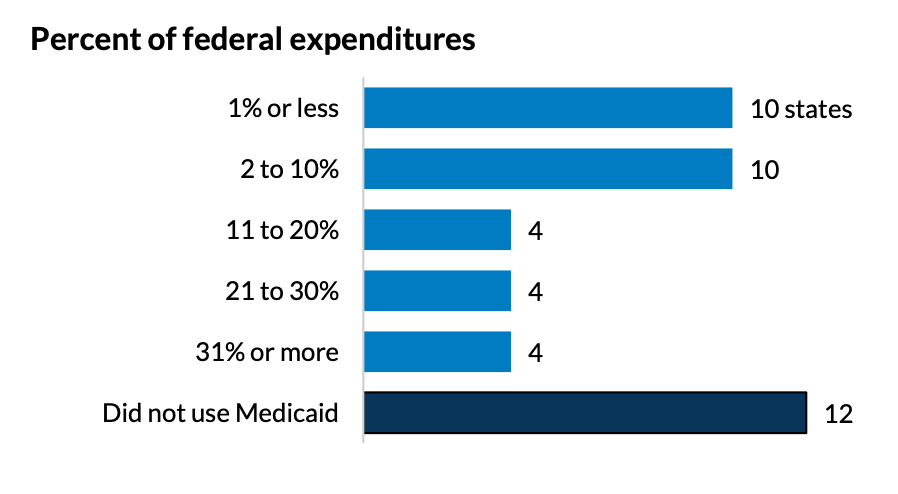Medicaid
In 1965, Congress created Medicaid (Title XIX of the Social Security Act, P.L. 89-97).1 It’s a state-federal partnership. States don’t have to participate, but all do.2
The U.S. Centers for Medicare and Medicaid Services (CMS) oversee Medicaid through the Center for Medicaid and CHIP Services (CMCS).
Medicaid by the Numbers
Together with the Children’s Health Insurance Program (CHIP), it covers 77.9 million people, making it the single largest source of U.S. health coverage.3
It also is the largest payor of mental health services in the U.S.4
FY 2024 Federal Medicaid Spending: $618 billion5
Per child annual federal medicaid cost: $2,0106
Average number of children on Medicaid per month: 37 million7
Who Medicaid Covers
Income and other factors impact Medicaid eligibility.8
Medicaid beneficiaries include:
Children;
Pregnant women;
Parents;
Seniors;
Individuals with disabilities; and
Certain low-income adults
Interestingly, drafting soldiers during the Vietnam War led to one of Medicaid’s child benefits, the Early and Periodic Screening, Diagnosis, and Treatment (EPSDT) benefit.
This grew out of the health exams of young prospective soldiers. Many had health issues preventing their service, but which early intervention would have addressed.9
EPDST ensures Medicaid-enrolled children under 21 get appropriate preventive, dental, mental health & specialty services, even ones Medicaid doesn’t usually cover.
How Medicaid Works
States have plans that outline how their Medicaid system operates. In negotiation with CMS, they can also develop amendments to their state plans.
States also have access to waivers for things such as innovation (1115 waivers) and providing home and community-based services (HCBS AKA 1915(c) waivers).
A good overall resource is Medicaid.gov, where you can view:
An overview of 1115 waivers and a list of all current waivers
These demos must be cost-neutral, and allow states to experiment
CMS reimburses states for permissible expenditures according to the state’s Federal Medical Assistance Percentage (FMAP).10
This number is also important because beyond Medicaid, it drives state reimbursements across many other child welfare programs.
Given the complexity of Medicaid financing and policy, there is an entire non-partisan independent legislative branch agency on it.
The Medicaid and CHIP Payment and Advisory Commission (MACPAC) provides Congress and HHS with analysis and recommendations for Medicaid and CHIP policy.
MACPAC has done some good child welfare specific resources on Medicaid, including:
2015 Report The Intersection of Medicaid and Child Welfare
Breaks down demographics, health needs, and behavioral health utilization
A 2021 report Medicaid Coverage of Qualified Residential Treatment Programs for Children in Foster Care
Note- this week’s 2/28 MACPAC meeting will have discussion on health access for children in foster care
Medicaid and Child Welfare
Medicaid plays a critical role in supporting children, parents, and caregivers who are in or could enter the child welfare system.11
Children in foster care experienced trauma and have significant health needs. Up to:
80 percent enter care having a significant mental health need;
Three quarters enter having at least one physical health problem;
One-third enter with a chronic condition.
Medicaid covers 99 percent of children in foster care,12 and the ~18,000 children who age out of foster care to age 26.13 Medicaid also does so much for their families.
Parents And Relative Caregivers
We know that at least a third of children entering care do so at least in part because of “parental drug abuse”. At least six percent are from“parental alcohol abuse”.14
Medicaid is key for funding their treatment, helping families heal from intergenerational trauma and can prevent unnecessary foster care.
Children’s coverage through Medicaid eliminates the barriers that can otherwise prevent relatives from providing kinship care, promoting family connection.15
Adoptive Families
Medicaid also plays a key role in the stability of adoptive families. Almost 30 percent of children exiting care join an adoptive family. That was 53,665 in FY 2022.16
Children adopted from care have significant trauma histories and health needs. They get categorical eligibility for Medicaid, covering care even private insurance won’t.17
Child Welfare Agencies Also Receive Medicaid Funds
In addition to Medicaid covering this population, child welfare agencies also receive additional Medicaid funding for health services they directly provide, including:
rehabilitative services;
targeted case management; and
treatment foster care.
In SFY 2020, child welfare agencies spent $1 billion in Medicaid funds for child welfare activities. Representing 7% of all federal funds child welfare agencies spend.
That’s more than Title IV-B and the Child Abuse Prevention and Treatment Act. And in some states it’s almost a third of federal child welfare spending.

Medicaid is a major source of coverage for children generally, and especially children and families in or at risk of entering the child welfare system.
Wonk Out
MACPAC statutory reference guide to Medicaid statute and regulations
Most recent Medicaid Access Rule
See this from Medicaid.gov, and this deeper dive from KFF
See this CBO baseline projection.
See the same CBO baseline projection.
This Kaiser Family Foundation tool offers up-to-date FMAP rates by state, projected from the underlying data as outlined in the most recent payment rules in the Federal Register
For more, I wrote a blog here and this paper.
See this CRS report
This is modeled on the dependent coverage to age 26 for commercial insurance, which allows young adults to keep coverage through a paren




